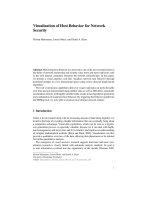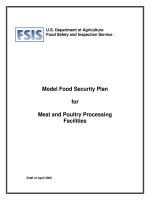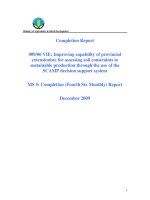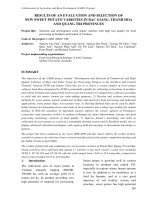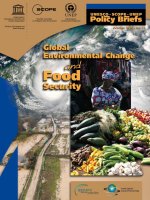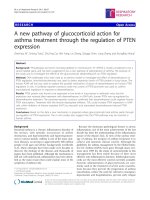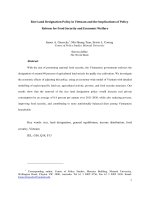Promotion of foxtail millet for food security through front line demonstration
Bạn đang xem bản rút gọn của tài liệu. Xem và tải ngay bản đầy đủ của tài liệu tại đây (213.71 KB, 4 trang )
Int.J.Curr.Microbiol.App.Sci (2018) 7(8): 4036-4039
International Journal of Current Microbiology and Applied Sciences
ISSN: 2319-7706 Volume 7 Number 08 (2018)
Journal homepage:
Original Research Article
/>
Promotion of Foxtail Millet for Food Security through
Front Line Demonstration
S. Vanishree1*, G.N. Maraddi2 and Aravind Rathod3
1
Department of Home Science, 2Department of Agriculture Extension, Agriculture Extension
Education Centre, Lingasugur, UAS Raichur, Karnataka, India
3
SMS Horticulture, Agriculture Extension Education Centre, Lingasugur, UAS Raichur,
Karnataka, India
*Corresponding author
ABSTRACT
Keywords
Millets, Variety, Value
addition, Capacity
building, Processing
Article Info
Accepted:
22 July 2018
Available Online:
10 August 2018
A study was conducted during 2017-18 under the jurisdiction of Agricultural Extension
Education Centre Lingasugur, University of Agricultural Sciences, Raichur. The purpose
was to promote growing and consumption of foxtail millet to achieve the food security
through Front Line Demonstration and by capacity building program. The problems in
adopting foxtail millet crops were also analyzed through pre structured schedule. Foxtail
millet seeds (HMT 100-1) were distributed to randomly selected beneficiaries under
NFSM (National Food Security Mission). Results revealed that the improved variety HMT
100-1 gave higher yield (5.33qtls/acre) compared to farmer’s local variety (4.13qtls/acre).
Lack of processing industries, marketing and availability of high yielding varieties were
the major problems as expressed by the farmers in adopting foxtail millet. To enhance the
consumption, foxtail millet based recipes were demonstrated in capacity building
programmes. Among the value added millet products, Foxtail millet papad scored higher
mean value followed by plain rice and bisebele bath.
Introduction
Millets are the future crops of India. They
include number of small grained cereals.
Based on grain size, millets have been
classified as major millets (Sorghum and Pearl
millet) and minor millets (Finger millet,
foxtail, kodo, proso, barnyard and little
millet). Foxtail millet (Setaria italic L) is an
important food grain crop of the semi-arid
tropics in India. It is drought tolerant crop
cultivated mainly for food grain and fodder for
livestock. Grains are highly nutritious with
good amount of dietary fibre, phytochemicals, vitamins and lower glycemic
index.
Foxtail grain contains 10-12% protein, 4.7%
fat, 60.6 % carbohydrates, 2.29 % -2.7%
Lysine and 0.59mg Thiamine (Chapke et al.,
2018) the present study was undertaken with a
view to promote growing and consumption of
4036
Int.J.Curr.Microbiol.App.Sci (2018) 7(8): 4036-4039
millets thereby achieving food security by
introducing High Yielding Variety HMT 1001.
Materials and Methods
Present study was conducted in Lingasugur
taluk of Raichur district, Karnataka. Thirty
farmers were selected randomly from three
villages (Adavibavi, Basapura and Buddinni)
based on their interest and HMT 100-1 seeds
were distributed under NFSM-coarse cereals
(National Food Security Mission).
A pre structured schedule was administered to
collect the information on problems
encountered in adopting foxtail millet crop,
processing and adopting millet as a source of
daily food. Capacity building programmes
were organized to enhance their knowledge on
nutritional and health aspects of millets and
their utilization in regular diet. Different value
added products were demonstrated to the
selected beneficiaries and their acceptance
was evaluated by Weighted Mean Score.
Results and Discussion
It is observed from the table 1 that lack of
millet processing industries (100%) in their
area was the major problem expressed by
farmers followed by marketing problem
(26.00%), availability of High Yielding
Varieties (25.00%), lower economic returns
(24.00%) and lack of acceptance as regular
food (76.66%). Incorporation of millets in the
conventionally used refined wheat flour can
improve nutritional quality (Shrestha and
Srivastava, 2015).
The major factor discouraging its cultivation
and consumption with improvement in living
standard or urbanization is the drudgery
associated with its processing as stated in the
study conducted by Vanithasri and Kanchana,
2013.
In addition, a combination of factors like low
remuneration as compared to other food crop,
lack of input subsidies and price incentives,
subsidized supply of fine cereals through
public Distribution System (PDS) and change
in consumer preference (difficulty in
processing, low shelf life of flour and low
social status attached to millets) have led to
shift from production of millets to other
competing crops were also the problems as
narrated by Pthak (2013).
Performance of improved variety HMT 100-1
was better compared to local variety in all the
demonstration plots as observed in table 2.
About 25 per cent of increase in yield was
observed. Thus introduction of High Yielding
Varieties proved to increase yield, which in
turn increases economic returns. Similar
results narrated by Kammar and Vanishree
(2017).
Table.1 Problems identified in growing of millets by farmers N=30
No
1
2
3
4
5
6
Problems
Non-availability of High Yielding Varieties
Lack of millet processing industries
Problem in marketing of millets
Lack of knowledge about health benefits
Lack of acceptance as regular food
Lower economic returns
4037
%
25 (83.33)
30 (100)
29 (96.66)
26 (86.66)
23 (76.66)
24 (80.00)
Int.J.Curr.Microbiol.App.Sci (2018) 7(8): 4036-4039
Table.2 Performance of HMT-100-1 over local varieties
Name of the
village
Muski
Basapura
Buddinni
Total
Number of
beneficiaries
Yield
Local variety
HMT 100-1
5
10
15
30
4.1
4.0
4.3
4.13
5.2
5.0
5.4
5.33
% increase over
local
26.82
25.00
25.58
25.80
Table.3 Preference of value added products by beneficiaries
Recipies
Upama
Bisebelebath
Roti
Rice
Thalipet
Papad
Always
16
18
15
17
12
20
Sometimes
14
10
16
13
17
9
Among the foxtail millet value added
products, papad scored highest mean value
(2.63) followed by foxtail rice (2.56) as
narrated in table 3. Upama and bisibelebath
both scored same mean values (2.53).
However less mean value was scored by roti
(1.86) which indicates foxtail millet roti was
less preferred by the respondents. This
indicated that foxtail millet was very much
suitable for making papad and rice. In
addition, their preference for rice items like
bisibelebath and thalipet found to be higher
compared to roti, which indicates millets can
be used in place of paddy.
Introduction of High Yielding Varieties to
farmers can be helpful in adopting millet
crops. Demand for millets can be increased by
creating
awareness
regarding
their
environmental sustainability, nutritional and
other health benefits. Measures need to be
taken to making them available through
Public Distribution System. So that it reach to
all categories of population. Further, millet
value added products can be included under
Never
WMS
1
2
9
1
1
2.53
2.53
1.86
2.56
2.36
2.63
feeding programmes like mid-day meal and
adolescent feeding programmes.
References
Chapke, R. R., Prabhakar, Shyam Prasad, G.,
Das, I. K., and Tonapi, V. A., 2018,
Improved
millets
production
technologies
and
their
impact.
Technology bulletin, ICAR- Indian
Institute of Millet Research, Hyderabad,
pp-1-5
Kammar, M. R. and Vanishree, S., 2017,
Entrepreneurship
development
promotion through
Millet processing in Raichur district of
Karnataka State, India. Plant Archives,
17(2):1460-1462.
Pathak, H. C., 2013, Role of millets in
nutritional security of India. Policy
paper by NASS, pp-1-4.
Srestha, R. and Srivastava, S., 2015,
Functional properties of finger millet
and barnyard millet flours and flour
4038
Int.J.Curr.Microbiol.App.Sci (2018) 7(8): 4036-4039
blend. International Journal of Science
and Research, 6(6):775-779.
Vanithasri, J and Kanchana, S., 2013, Studies
on quality evaluation of idli prepared
from barnyard millet (Echinochola
frumentacaea). Asian Journal of Home
Science, 3(2):373-378.
How to cite this article:
Vanishree, S., G.N. Maraddi and Aravind Rathod. 2018. Promotion of Foxtail Millet for Food
Security through Front Line Demonstration. Int.J.Curr.Microbiol.App.Sci. 7(08): 4036-4039.
doi: />
4039
